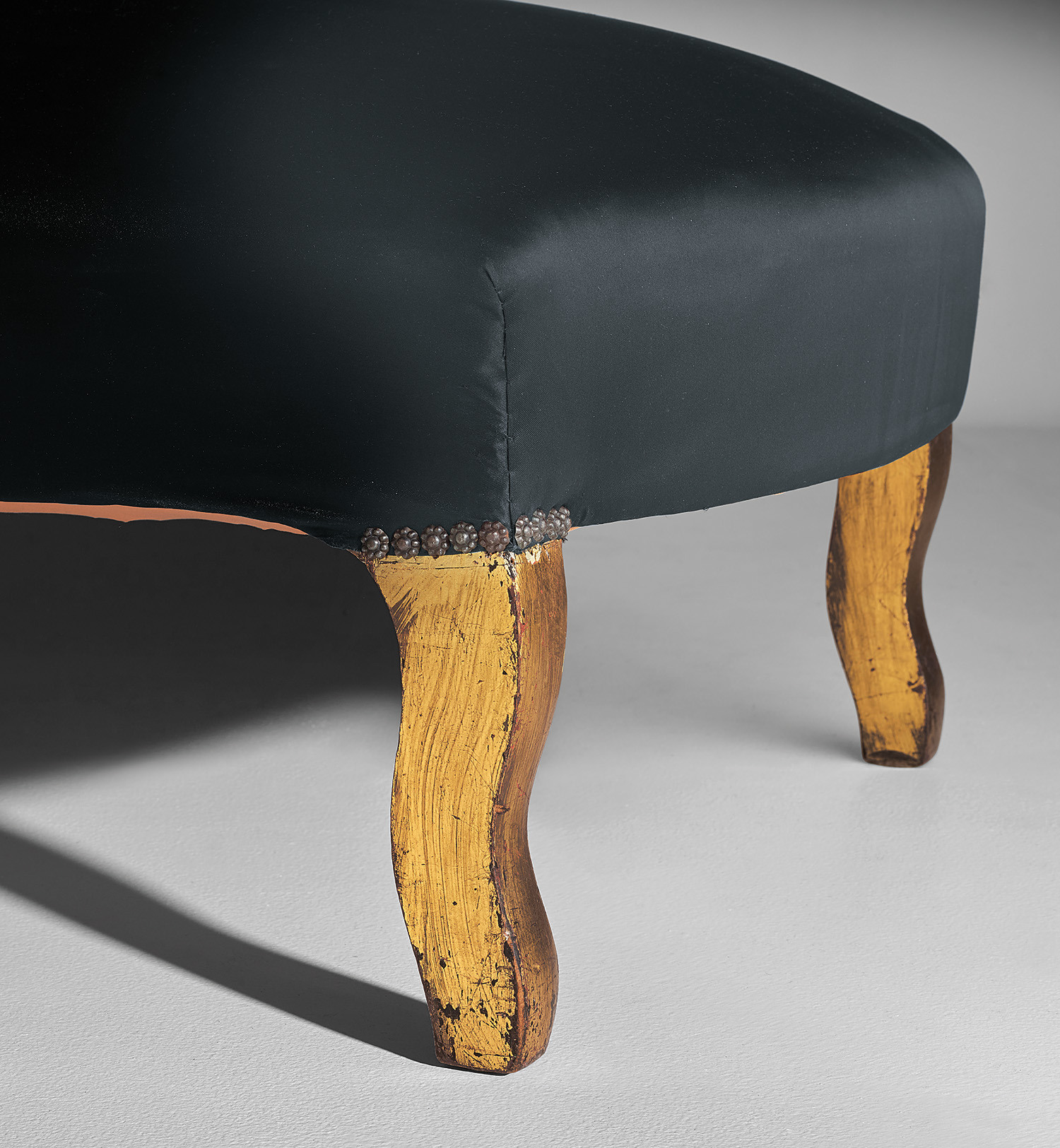



12
Carlo Mollino
Unique pair of lounge chairs, designed for the living room of the Ada and Cesare Minola House, Turin
Full-Cataloguing
Carlo Mollino's Lounge Chairs for Ada and Cesare Minola House
The present pair of lounge chairs formed part of an intricate interior composition comprised of expressive furniture designed by the Italian architect Carlo Mollino for Ada and Cesare Minola’s residence in Turin between 1944 and 1946. Inherent in the chairs themselves is the architect’s predilection for synthesis; Mollino combined varied cultural sources to create his iconic and highly individualised designs. Informed by Surrealism, he sought to escape from the ‘cul de sac of rationalism’ prominent in Italian design of the period, creating furniture motivated by his own creative impulses. Celebrated as one of Mollino’s most important projects, the Minola house featured experimental, custom designs that reflect the architect’s development of organic forms, transforming the space and affectionately combining a sense of history and modernity.
The lounge chairs’ curvilinear form echoes the Surrealist incorporation of naturalistic objects into their work. Surrealist landscapes often featured organic shapes in dream-like surroundings reflecting the interior world of the artist’s psyche. Mollino designed the pair of lounge chairs for the living room of the Minola house. The room’s furnishings were set against a dynamic etched mural depicting a waterfall surrounded by forest, which visually extended out towards the space’s inhabitants; reflected in a large horizontal mirror hung across the wall of the adjoining dining room, the space recalls the dreamscapes of Salvador Dalí. The biomorphic, draping forms frequently featured in these compositions are evoked by Mollino’s lounge chairs and, as in Dalí’s paintings, Mollino’s interior combines disparate parts, exploring the parallel between the world of reality and imagination.
Mollino shared with Dalí an interest in Art Nouveau, whose sensuous, organic curves are expressed in the profile of the present lounge chair design. Many buildings in Turin had been built in the stile Liberty – a movement which also influenced the jewellery designs of Ada Minola for whom the interior was designed. The exaggerated form of the lounge chairs also references the visual vocabulary of the Baroque, which sought to combine the physical and the spiritual and appeal directly to the viewer’s emotions. The lounge chairs’ curvilinear, reclining forms gesture to their use, giving the objects a sense of performance, reinforced by the room’s floor-to-ceiling velvet purple curtains, creating an intimate space that could be enclosed from reality. Mollino’s use of gilding for the legs also references Baroque furniture, whilst the draping form of the seat upholstered in black fabric is evocative of a nun’s habit; such details emphasise the theatrical nature of the lounge chairs, whose design is at once highly imaginative and controlled.
Additional stylistic influences evident in the lounge chairs may be traced further back to antiquity. Mollino was fascinated by Ancient Egyptian culture and his designs demonstrate an archaeological spirit, expressively appropriated in the lounge chairs’ scrolling back and distinctly low seat. In 1948 Gio Ponti featured the Minola house in Domus, in which he celebrated the ‘artistic value’ of the project, describing the designs as originating from ‘the free enthusiasm for the extraordinary ideals of ancient times’.
Whilst Mollino’s designs may be considered through varied historical and cultural references passionately explored by the architect throughout his career, the works nevertheless retain a sense of mysterious anonymity. Mollino’s translation of the female form into his designs was cardinal to his inspiration. However, whilst feminine curves are explicit to Mollino’s furniture designs, the specific source of the forms remain anonymous. Such constructed anonymity is revealed in the collection of over one thousand Polaroid portraits depicting unidentified models staged and photographed by Mollino, which were found in the architect’s personal collection following his death.
Mollino’s approach to design was highly intuitive and instinctive, synthesising sources of inspiration to create an entirely new visual language that existed outside the framework of his contemporaries. Consequently Mollino’s furniture reveals a human quality, enhanced by his preoccupation with anthropomorphic and organic forms. Capturing a sense of the feminine and the surreal, the present pair of lounge chairs oscillate between the architectural and the artistic – Mollino being both engineer and artist.
Carlo Mollino
Italian | B. 1905 D. 1973Carlo Mollino made sexy furniture. His style may have grown out of the whiplash curves of Art Nouveau, but the sinuous lines of his furniture were more humanoid than vegetal, evoking arched backs and other body parts. Mollino was also an avid aviator, skier and racecar driver — he designed his own car for Le Mans. His love of speed and danger comes across in his designs, which MoMA curator Paola Antonelli has described as having "frisson."
Mollino had no interest in industrial design and the attendant constraints of material costs and packaging. His independent wealth allowed him to pick and choose projects, resulting in an oeuvre of unique, often site-specific works that were mostly executed by the Turin joinery firm Apelli & Varesio. Apart from a coffee table that he designed in 1950 for the American company Singer & Sons, his furniture never went into production. Notwithstanding the support of Gio Ponti, Mollino's design contemporaries largely dismissed him as an eccentric outsider. However, the combination of scarcity (Mollino only made several hundred works in his lifetime), exquisite craftsmanship and idiosyncratic "frisson" has rightly placed Carlo Mollino in the highest tier of twentieth-century design collecting.